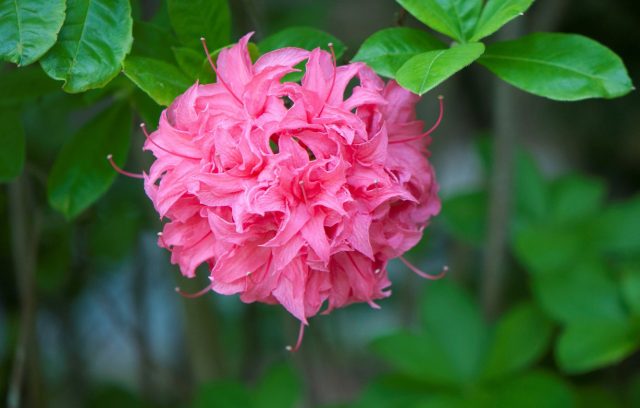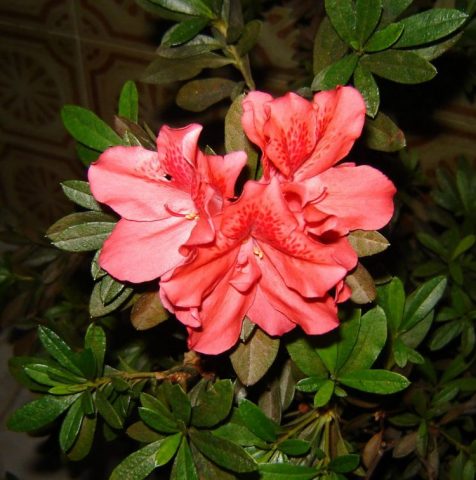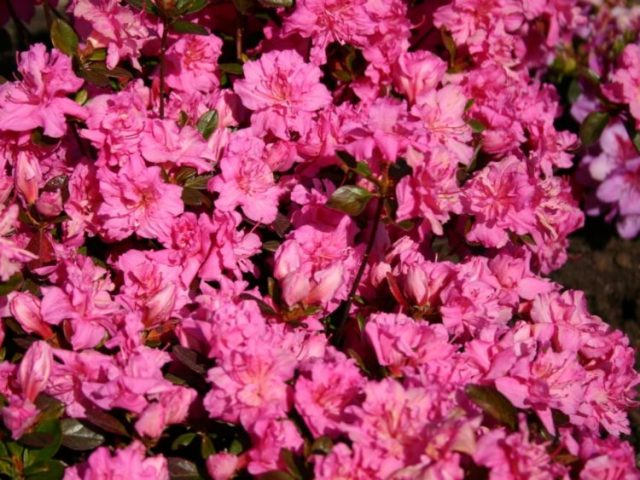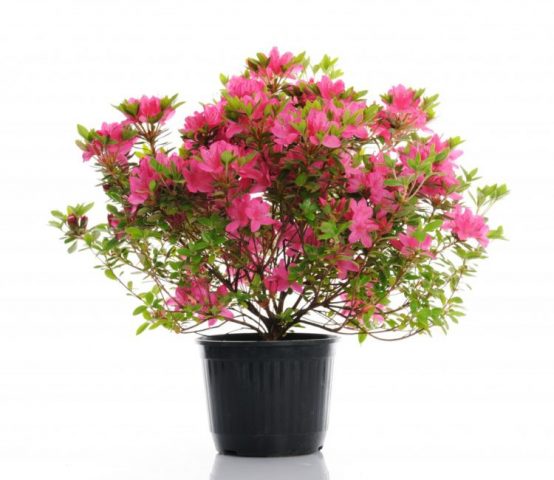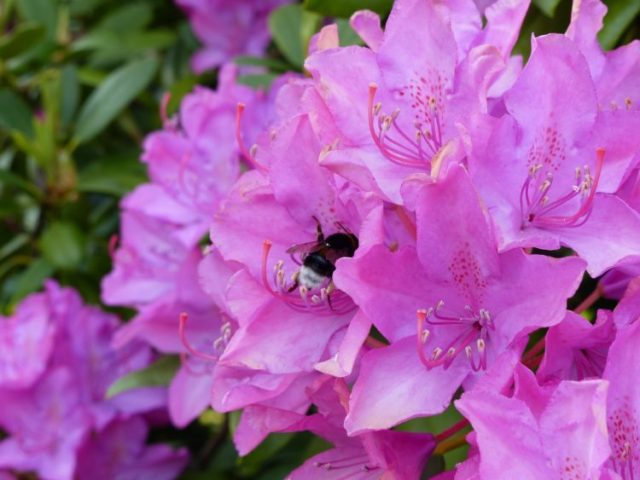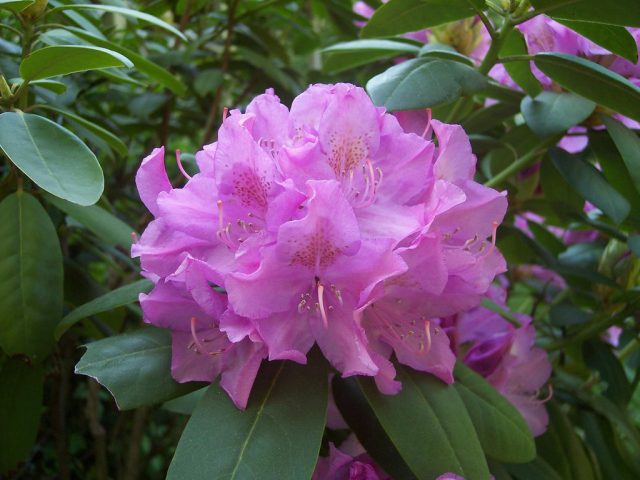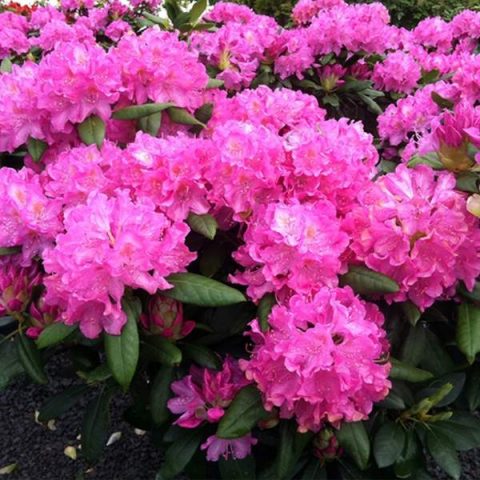Content
Pink rhododendron will not leave anyone indifferent. After all, the plant has not only delicate and exquisite flowers, but also an unforgettable aroma. This azalea comes in a variety of varieties. Rhododendron pink can be grown as a tree or shrub.
Description of pink rhododendron
Azalea pink is a representative of the genus of rhododendrons from the Heather family. It is a beautiful, lush blooming bush with many branches and small leaves. In their natural environment, rhododendron bushes with pink flowers are found in Asia, Japan, China and North America.
Rhododendron pink Amoena, like other representatives of the culture, is a perennial, evergreen or semi-deciduous plant. As a rule, azaleas grow in one place for about 10 years. The height of a shrub or tree is up to 2 m, depending on the variety of pink rhododendron.
The foliage is medium in size, the length of the lanceolate plates is from 2.5 to 3 cm. They are smooth, on the top of the natural gloss. The leaves are bright, dark green.
The flowering is plentiful, the plants bloom (depending on the variety) buds of all kinds of shades of pink:
- rhododendron white and pink;
- rhododendron dark pink;
- pastel;
- mixes are pink and white.
Pink rhododendrons bloom for about 1.5 months. The buds are collected from the inflorescence in several pieces. Flowers are double, semi-double, shiny or matte. The shape of the bud is flat, tubular or funnel-shaped, like a bell. The sizes of the inflorescences are from small to gigantic.
Most varieties of pink rhododendron bloom profusely, so that during this period the leaves and branches are practically invisible. You can improve flowering with proper pruning.
The growth of the bush is slow, but it remains compact. Young shoots are highly branching, so they need to be thinned, this also contributes to abundant flowering.
Pink rhododendron varieties
Rhododendron pink, as a cultivated plant, is relatively young, appeared in gardens at the beginning of the 20th century and was called the Kurum azalea. Since his homeland is a state with a warm climate, the plant did not take root in Europe due to frost and winds.
Breeders did not want to lose such a lush plant and created new varieties of hybrid pink rhododendron. They were given frost resistance, so the culture grows well in the gardens of Russians.
Here are some varieties of pink rhododendron with a photo.
Pink lights. Bushes with a dense crown, up to 1.4-1.5 m high, leathery, shiny leaves. A low-growing clone-like shrub with bright, deep pink flowers, the diameter of which is from 3.5 to 4 cm.The flowers themselves are medium in size - 3.5-4 cm in length. On the upper petal there is an ornament in the form of maroon specks. Rhododendron pink frost-resistant, does not freeze at temperatures of -30-35 degrees.
Elegant. The variety attracts with large clusters of pink inflorescences, each of which has up to 20 double buds. Differs in curly petals of lilac-lavender shade. During flowering, bees hum over the bushes, which are attracted by the aroma. A slow-growing shrub, an adult plant can be no higher than 2 m.
Rhododendron pink Micrantum. The word is translated as "small-flowered". The variety is suitable for growing in a pot culture. Leaves are small, leathery, shiny.The crown grows well, it is easy to form it in the form of a hemisphere. Abundant flowering, pink buds up to 3 cm in diameter.
Elsie Lee... Rhododendron of this variety stands out with a spreading loose crown with light green leaves of medium length. The height and width of the bush is about 80 cm. The plant pleases the eye with large double purple buds. On the petals, 8-9 cm long, there are pink dots. Feels better in a secluded, wind-protected place. Rhododendron Elsie Lee pink frost-resistant.
Rhododendron Sintillation. This variety is considered the best in the collection of Charles Dexter. It grows very slowly. The crown of an evergreen and compact shrub grows in height and width up to 1.5 m. The hybrid Sintillation rhododendron has pink flowers, delicate, large, spherical in shape. Inflorescences are purple-pink. Grows well on drained acidic soils. In a harsh winter, it is necessary to shelter.
Rhododendron Natalia pink. Variety with large matte leaves, compact. Plant height - up to 1 m. Recommended as a pot culture. The flowers are pale pink.
Rhododendron English pink. The plant is best planted in partial shade. It blooms with pink-lilac buds. There are bright specks on one petal. The variety is frost-resistant, can withstand temperatures up to -32 degrees.
Rhododendron pink Elegant. Bushes high (up to 3 m) attracts with their spreading. The shape of the crown is spherical, up to 3.5 m in diameter. The leaves are medium-sized, dark green. Flowering begins in May, the inflorescences are pale pink, the petals are wavy at the edges. Each inflorescence has up to 20 buds. According to the description, Rhododendron pink Elegant is frost-hardy, but does not tolerate drought.
Rhododendron pink Christian Pink... The shrub grows slowly, at 10 years old - no higher than 60 cm. That is why it can be grown in pots. On the dark green lanceolate leaves, a silvery pile is clearly visible on top. Abundant flowering, long-lasting, begins in May. The buds are brownish-red or purple, collected in inflorescences, resembling bells in shape.
Planting and caring for pink rhododendron
Rhododendrons are picky plants, they are picky about the soil. To grow an abundantly flowering plant, you need to understand the rules of agricultural technology. You can plant seedlings in spring or early autumn so that the bushes have time to take root. Further care for pink rhododendrons comes down to traditional activities.
Selection and preparation of the landing site
For planting, choose places where there is enough light. But there should be trees nearby, which in time will give shade and cover the bushes from the rays of the scorching sun. It should also be understood that pink rhododendron is not planted in a dense shade, since it will not please with flowering.
Plants do not tolerate drafts. As for the soil, it is better if it is acidic. With neutral soils, the top layer is removed by 50 cm and a mixture of peat, sand and earth from under coniferous trees is added instead.
Seedling preparation
For planting, you need to choose healthy seedlings. They can be identified by flex branches. Plants should be free of signs of diseases and pests. Before planting, rhododendrons are soaked in water with a rooting agent so that the roots are saturated with moisture. Plants in containers are filled with water.
Planting rules for pink rhododendron
Garden rhododendrons have a superficial root system, they do not require a deep hole.
Planting stages:
- The planting pit should be 50 cm deep, no more than 70 cm in diameter. The bottom is filled with drainage to a height of 15-20 cm with broken brick, sand or expanded clay.
- Sand, peat, humus are added to the soil from the pit and mixed thoroughly. Then the hole is filled up by a third.
- A mound is made in the center and a seedling with an open system is planted. If it is a container plant, then the rhododendron is installed along with a clod of earth.
- Sprinkle the plants so that the root collar remains above the surface.
- The soil is carefully tamped to expel air bubbles and watered.
- To retain moisture and prevent weeds from growing, mulch is poured into the trunk circle: needles, moss, peat or crushed bark.
Watering and feeding
Rhododendron pink is picky about watering. The topsoil should always be moist. If the soil is not too acidic, citric acid can be added to the water (for 2 liters of liquid, 1 tsp. Of the substance).
In early autumn, watering should be done less often so that new shoots do not start to grow, and before the onset of frost, water charging should be carried out. In hot weather, the bushes are sprayed, but not during flowering!
Weeds must be removed, but it is not recommended to loosen the trunk circle, since the roots are located close to the surface.
Bushes are fed:
- Early in the spring with a solution of humus.
- Before flowering, plants require nitrogen, potash and phosphorus fertilizers (equally).
- Potash and phosphorus fertilizers (1: 2) are fed at the end of flowering.
Pruning
Spring is the time for sanitary pruning. The next time the pruner is picked up after flowering in 2-3 weeks. This is the time of the shaping haircut. Peduncles, extra branches are removed, the shoots are shortened by a third.
Preparing for winter
Before wintering, the root system of a pink-white azalea is covered with a thick layer of mulch. In harsh climatic conditions, the bushes are loosely pulled together with twine. Low plants are covered with spruce branches, tall ones are wrapped in burlap.
Reproduction
For reproduction, you can use any of 3 methods:
- cuttings;
- layering;
- division of the bush.
All of them are convenient, and a novice gardener can handle them.
Diseases and pests
Rhododendrons, unlike other cultivated plants, rarely get sick and are affected by pests.
Diseases and pests | Measures |
Phytophthora | Spray "Fitoverm" |
Necrosis | Protect bushes from drafts |
Chlorosis of leaves | If the water is hard, add citric acid when watering, water the flowers with iron chelate |
Rhododendron bugs | Treat the bushes with Diazinon solution |
Spider mite | Washing foliage with soapy water, spraying with Aktellik |
Azalea moth | Sulfur treatment of plants |
Mealybugs | Spray plantings with insecticides |
Conclusion
Rhododendron pink is a great option for garden decoration. Despite the fact that the plant is finicky, the end result cannot but rejoice: lush flowering shrubs with bright flowers will appear on the site.
